Dangerous goods (DGR) handling information
Next Day Delivery Service for Main Asian Cities! Specialist of Express Logistics, OCS!
What is DG(Dangerous Goods)?
Dangerous Goods are articles or substances which are capable of posing a risk to health, safety, property or the environment and which are shown in the list of dangerous goods in the IATA DG Regulations or which are classified accoring to the IATA DG Regulations. The Dangerous Goods Regulations, referred to as the "DGR", prescribe the detailed requirements applicable to the international transport of dangerous goods by air under normal circumstances.
Some dangerous goods are too dangerous to be carried by aircraft, others may be carried on cargo aircraft only and some are acceptable on both cargo and passenger aircraft. A number of limitations are placed on dangerous goods which are permitted to be transported by air.
< Main international rules >
- A.
The international Maritime Dangerous Goods Code(IMDG Code)
issued by International Maritime Organization(IMO) - B.
The Technical Instructions for the safe Transport of Dangerous Goods by Air
issued by International Civil Aviation Organization(ICAO) - C.
The European Agreement concerning the International Carriage of Dangerous Goods by Road(ADR)
issued by Economic Commission for Europe(ECE) - D.
The European Provisions concerning the international Carriage of Dangerous Goods by Inland Waterways(AND)
issued by Economic Commission for Europe(ECE) - E.
The Regulations concerning the International Carriage of Dangerous Goods by Rail(RID)
issued by Centeral Office for International Carriage by Rail
Dangerous goods are defined as those goods which meet the criteria of one or more of nine UN hazard classes and, where applicable, to one of three UN Packing Groups according to the provisions of the DGR. The nine classes relate to the type of hazard whereas the packing groups relate to the applicable degree of danger within the class.
Some hazard classes are further subdivided into hazard divisions due to the wide scope of the class. The nine hazard classes and their divisions are listed as below. The order in which they are numbered is for convenience and does not imply a relative degree of danger.
| Class | Division | Explanation |
|---|---|---|
| Class 1. Explosives | Division 1.1 | Articles and substances having a mass explosion hazard. |
| Division 1.2 | Articles and substances having a projection hazard but not a mass explosion hazard. | |
| Division 1.3 | Articles and substances having a fire hazard, a minor blast hazard and/or a minor projection hazard but not a mass explosion hazard. | |
| Division 1.4 | Articles and substances presenting no significant hazard. | |
| Division 1.5 | Very insensitive substances having a mass explosion hazard. | |
| Division 1.6 | Extremely insensitive articles which do not have a mass explosion hazard. | |
| Class 2. Gases | Division 2.1 | Flammable Gas |
| Division 2.2 | Non-flammable Gas/Non-toxic Gas | |
| Division 2.3 | Toxic Gas | |
| Class 3. Flammable Liquids | ||
| Class 4. Flammable Solids | Division 4.1 | Flammable Solids |
| Division 4.2 | Substances Liable to Spontaneous Combustion | |
| Division 4.3 | Substances Which, in contact with Water, Emit Flammable Gases | |
| Class 5. Oxidizing Substances and Organic peroxides | Division 5.1 | Oxidizing Substances |
| Division 5.2 | Organic peroxides | |
| Class 6. Toxic and Infectious Substances | Division 6.1 | Toxic |
| Division 6.2 | Infectious Substances | |
| Class 7. Radioactive Materials | ||
| Class 8. Corrosives | ||
| Class 9. Miscellaneous Dangerous Substances |
For packing purposes, substances are assigned to the relevant packing group according to the degree of danger they present:
| Class | Division |
|---|---|
| Packing Group(PG) Ⅰ | high danger |
| Packing Group(PG) Ⅱ | medium danger |
| Packing Group(PG) Ⅲ | low danger |
Packing Group is the selection criteria of the available containers, and the basis of the allowance per packaging goods, also has a very important significance, such as that based on the performance level of the vessel at the time of the test. Dangerous Goods Packaging can know the exact way through Regulations (DGR and IMDG Code).
For more details of the DG packing, please contact your convenient DG packing companies.
Accurate Marking and Labelling of Dangerous goods packaging is an important part of safe transportation of dangerous goods.
Therefore Shipper (Shipper) is responsible for the correct Marking / Labelling on the packaging to transportation, Freight (Transporter) and the Dangerous Goods Handling staff of the Operator (airline) also confirm prior to shipping that exactly Marking / Labelling on all packages You should.
Marking and Labelling
- • It tells the hazardous materials packaging and the contents are what
- • Match shows that the dangerous goods packaging standards
- • And providing information for the safe handling and storage of Dangerous Goods Packaging
- • Indicate the nature of the dangerous substance.
MARKING
The shipper is responsible for all necessary marking and labelling of each package of dangerous goods, and each overpack containing dangerous goods, in compliance with the DGR. Each package must be of such a size that there is adequate space to affix all required markings and labels.
ㆍBasic Marking
- Proper Shipping Name(s)
- UN/ID Number
- Shipper and Consignee's Names and Addresses
ㆍAdditional Marking
| All Classes | Except some cases | "Net Quantity" and "Gross Weight" of each package |
|---|---|---|
| Class 2 | Frozen liquefied gas | “KEEP UPRIGHT”, “DO NOT DROP-HANDLE WITH CARE”, “THIS WAY UP” label |
| Division 6.2 | Infectious substances | Name and Phone number who has the responsibility of the shipment. |
| UN3373 | Biological substance | “BIOLOGICAL SUBSTANCE, CATEGORY B” or “CLINICAL SPECIMENS” |
ㆍUN Marking
- Marking The UN must be used whenever the UN packaging specifications.
- Examples of use : 
ㆍLimited quantities Marking
- "Y" limited quantity packaging using the packing instructions must be the following Marking.
- “LIMITED QUANTITY” or “LTD, QTY” 
ㆍSalvage Packaging's Marking
- When the packaging containing the dangerous goods that look something like damaged, defective or leaking, the returnable containers used in the packaging must be recovered or purpose of processing Marking called "SALVAGE".
ㆍEmpty Packaging's Marking
- Class 7, Except radioactive substances, packaging who has previously housed the Marking of Dangerous Goods must be the same as those required in the dangerous goods. However, if you have the following shall not apply.
1) If sufficiently cleaned so that no residue of dangerous goods of all risks and that the vapor emissions
2) If non-hazardous substances injected
ㆍAdditional Marking requirements
- Additional displays or symbols indicating precautions when handling or storage of packaged goods (eg cargo packaging this figure represents the shape of an umbrella should remain dry) can also be Marking on the packaging freight.
- Examples of use : 
LABELLING
Some exceptions, the packaging of all dangerous goods should be attached to the Hazard Label (Dangerous label).
For example, special magnetic materials "Magnetized Material" handling label is required and, "Battery-powered vehicle" (UN3171) is applied to the Special Provisions (special provisions) A87
Class 9 label is not required.
On the other hand, dangerous goods that have more than one risk may require Subsidiary risk Label.
ㆍClass 1 – Explosives

ㆍClass 2 – Gases
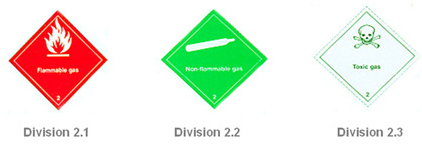
ㆍClass 3 – Flammable Liquids
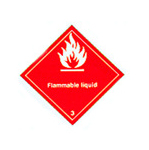
ㆍClass 4 – Flammable Solids

ㆍClass 5 – Oxidizing Substances and Organic Peroxide
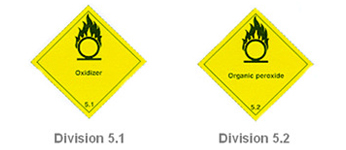
ㆍClass 6 – Toxic and Infectious Substances
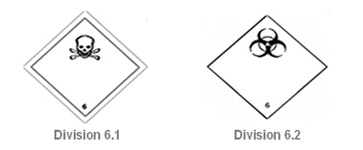
ㆍClass 7 – Radioactive Materials

ㆍClass 8 – Corrosives
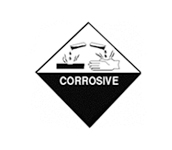
ㆍClass 9 – Miscellaneous Dangerous Goods

ㆍOther Handling Labels

Shipping Documents for DG
Exact documentation is required for the safe shipping of DG. Though the labels on the packages fully inform the details of the DG, it can be impossible to come close to the shipments to read it in any emergency. So, all documents with full information of DG must be always sent with the DG.
ㆍShipper’s Declaration for Dangerous Goods
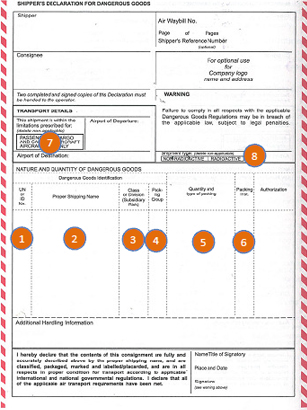
A "Shipper's Declaration for Dangerous Goods" must be completed by the shipper for each consignment of dangerous goods.
For the notification of these hazardous materials, a “'Shipper’s Declaration for Dangerous Goods” must be completed and signed by the shipper who knows the products best and the shipper has all responsibilities for the information provided.
1. UN or ID number of the DG.
2. Proper Shipping Name of the DG registered in UN/ICAO.
3. Class or Division (Subsidiary Risk)
4. Packing Group
5. Quantity and Type of Packing
6. Packing Instruction
7. Possibility of loading on Passenger flights.
8. Radioactive substances or not.
ㆍAir Way Bill
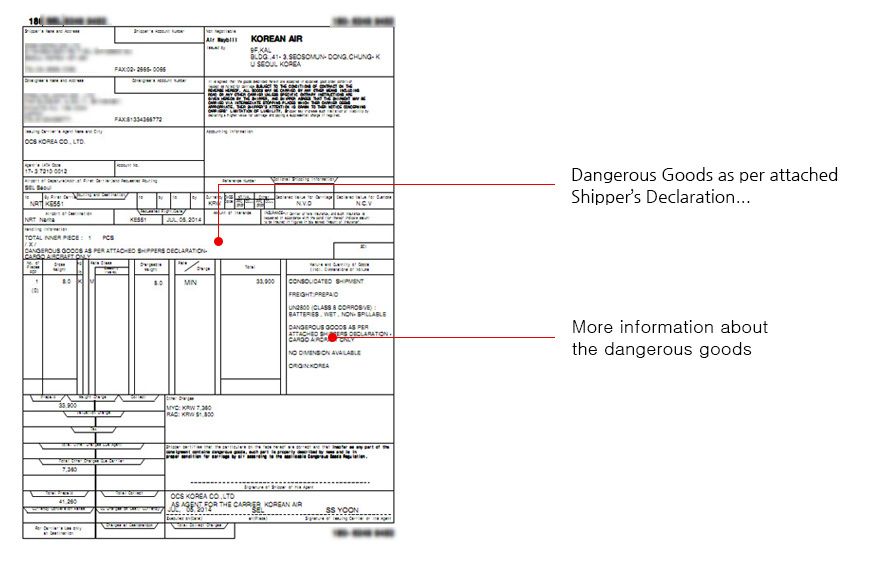
ㆍCOMMERCIAL INVOICE & PACKING LIST
ㆍMSDS (Material Safety Data Sheet)
Information required on a MSDS
- 1. Chemical Product and Company Identification
- 2. Composition, Information on Ingredients
- 3. Hazards Identification
- 4. First Aid Measures
- 5. Fire-fighting Measures
- 6. Accidental Release Measures
- 7. Handling and Storage
- 8. Exposure Controls and Personal Protection
- 9. Physical and Chemical Properties
- 10. Stability and Reactivity
- 11. Toxicological Information
- 12. Ecological Information
- 13. Disposal Considerations
- 14. Transport Information
- 15. Regulatory Information
- 16. Other Information


